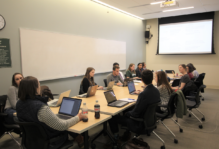Envisioning Shifts in U.S. Alliance Structure
By Brennen Micheal ’24
This post features a student’s reflections on “The Past, Present, and Future of U.S. Alliances,” a conference recently hosted by GRI’s Security & Foreign Policy Initiative. Student attendees had the chance to share personal insights, interpretations, and potential paths forward in these reflections. Any views expressed pertain to the authors themselves and not to the Global Research Institute.
In President Washington’s farewell address, he famously warned the young nation of the danger of permanent alliances. For much of history, the United States has heeded this warning and to great success. U.S. alliance strategy has primarily been flexible and beneficial for Washington’s interests. However, since emerging from the Cold War, the United States’ alliance structure has become rigid. Nowhere is this more evident than with NATO’s emerging focus on the Asia-Pacific, despite the major land-based war playing out on their doorstep.
The Past, Present, and Future of U.S. Alliances — a two-day conference hosted by William & Mary’s Global Research Institute — discussed this issue at length. As part of the Security and Foreign Policy Initiative, experts and policymakers gathered in Williamsburg, Virginia, to evaluate the challenges and opportunities in United States foreign policy. From this conference, my major takeaway was the scholarly disagreement surrounding the future of the United States alliance posture in the Asia-Pacific region.
Central to this conversation was the role an increasingly global-facing NATO will play in the United States’ strategic competition with China. The panelists, particularly Christopher Preble, Senior Fellow and Director of the Reimagining US Grand Strategy program at the Stimson Center, walked the audience through NATO’s evolving role in the world order. At first, NATO became increasingly involved in Asia through “out-of-area operations” in Afghanistan. Over time, the United States has exported its own “pivot to Asia” and is shaping NATO policy. NATO’s emerging norm involves inviting Australia, New Zealand, Japan, and South Korea to NATO Summits, with Seoul’s involvement at the direct request of Washington. Similarly, NATO’s newest Strategic Concept emphasized China as a principal threat and the Indo-Pacific as an essential line of effort. Most recently, Secretary General Stoltenberg’s visits to Tokyo and Seoul have sparked discussions on Atlantic-Pacific cooperation through NATO’s existing framework.

Over the two day conference, experts addressed topics such as the strategic future of U.S. alliances in the Asia-Pacific, the evolution of military assistance, and more.
However, with NATO expansion into Asia, the United States is undertaking what one panelist called a “great experiment.” The United States aims to ramp up existing efforts at alliance-building in Asia while integrating European-based collective security into a force for good worldwide. Not only does this go against traditional alliance logic, where partnerships are in response to geographically proximate threats, but it exhausts resources to build resilience in the Pacific directly. Never before has a nation taken an existing defensive alliance and repackaged it to fit a non-adjacent threat. One panelist argued that this depicts the United States’ outdated Cold War mentality in an emerging multipolar world.
Others argue that increasing collaboration between NATO and East Asia is a natural advancement of the liberal order, offering deterrence against China. However, while I hesitate to compare two vastly different geopolitical situations, a united democratic caucus did little to deter — or punish — previous Russian invasions into Georgia and Crimea. Similarly, with the current response to Ukraine, Germany greatly hesitated to assist against a historic adversary — waging unjust war in Europe — because it relied on Russian energy. Other NATO allies would be put in a similar situation in a conflict with China. With much of Europe increasingly reliant on Chinese trade and BRI investment, some states may be unwilling to jeopardize their access for a conflict halfway across the globe.
Based on the perspectives of many of the panelists and my own analysis, I conclude the United States should continue to improve multilateral and bilateral engagement through a regional-specific framework rather than adapting previous alliances to circumstances beyond their geographic scope and existing purpose. The United States should also encourage our European partners to continue increasing engagement bilaterally and through regional-specific partnerships like AUKUS and the Quad at their discretion. The United States has had many great successes in recent history, with the Mutual Defense Pact with the Philippines and Japan’s increased military commitment a positive sign for future collaboration. As competition heats up with China, the United States should focus on facilitating relationships with Pacific partners bilaterally and regionally, rather than through NATO’s existing institutions.




No comments.
Comments are currently closed. Comments are closed on all posts older than one year, and for those in our archive.